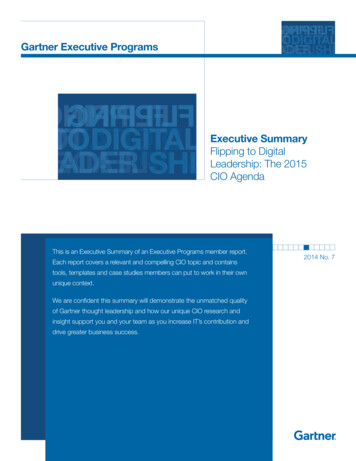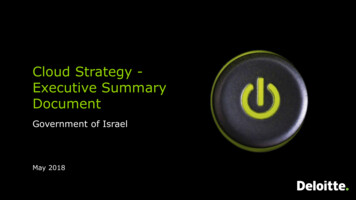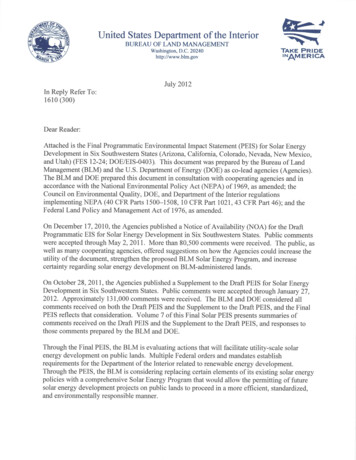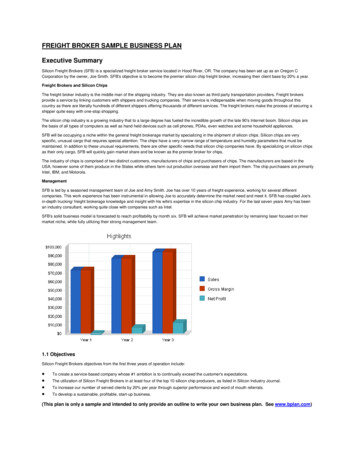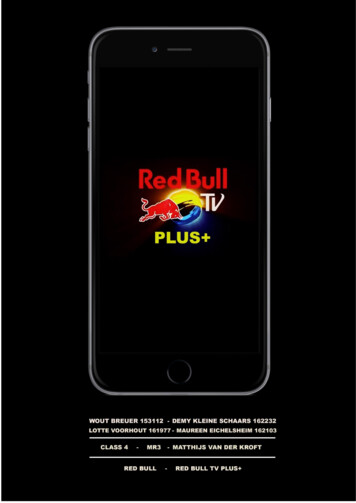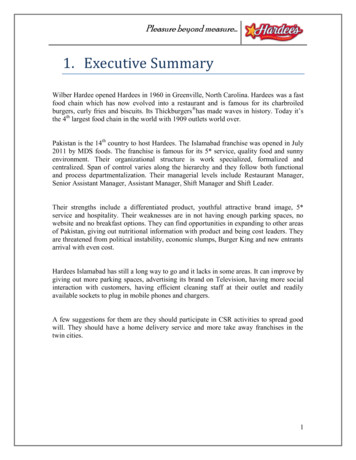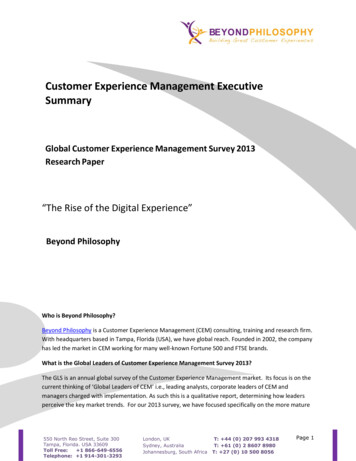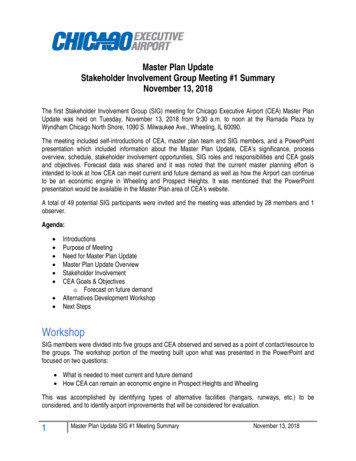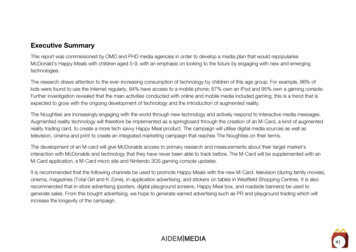
Transcription
Executive SummaryThis report was commissioned by OMD and PHD media agencies in order to develop a media plan that would repopulariseMcDonald’s Happy Meals with children aged 5-9, with an emphasis on looking to the future by engaging with new and emergingtechnologies.The research draws attention to the ever-increasing consumption of technology by children of this age group. For example, 86% ofkids were found to use the Internet regularly, 84% have access to a mobile phone, 67% own an iPod and 95% own a gaming console.Further investigation revealed that the main activities conducted with online and mobile media included gaming; this is a trend that isexpected to grow with the ongoing development of technology and the introduction of augmented reality.The Noughties are increasingly engaging with the world through new technology and actively respond to interactive media messages.Augmented reality technology will therefore be implemented as a springboard through the creation of an M-Card, a kind of augmentedreality trading card, to create a more tech savvy Happy Meal product. The campaign will utilise digital media sources as well astelevision, cinema and print to create an integrated marketing campaign that reaches The Noughties on their terms.The development of an M-card will give McDonalds access to primary research and measurements about their target market’sinteraction with McDonalds and technology that they have never been able to track before. The M-Card will be supplemented with anM-Card application, a M-Card micro site and Nintendo 3DS gaming console updates.It is recommended that the following channels be used to promote Happy Meals with the new M-Card: television (during family movies),cinema, magazines (Total Girl and K-Zone), in-application advertising, and stickers on tables in Westfield Shopping Centres. It is alsorecommended that in-store advertising (posters, digital playground screens, Happy Meal box, and roadside banners) be used togenerate sales. From this bought advertising, we hope to generate earned advertising such as PR and playground trading which willincrease the longevity of the campaign.#1
3DS Augmented reality.22Table of ContentsTraditional Game.22Trading.22Executive Summary.1Channel Recommendations.23Introduction.3Bought Media.23Business & Marketing Objectives.4Earned Media.25Communication Objectives.4Owned Media.25Market Analysis.5Budget Reserves for Recommended Research.28Competition and Market Share.5Campaign Evaluation Measures.29Target Audience.11References.30Pre Operation Thought Stage (PTO).11Appendix 1.31Ages 2-7 – Fledglings.11StrategyonaPage.31Concrete Operations Stage (CO).13Appendix 2.33Ages 7-11 – Confident Players.13Kids 5-9 years.15Communication Strategy.19Games.19Premium Games.20Happy Meal Menu.20M-Card.21Website Key.21Digital Screen Key.22#2
IntroductionMcDonald’s is a company positioned in the evoked set ofconsumers and has been for over 5 decades. The Happy Mealis a product that shapes a child’s imagination and excitementwhen they engage with McDonalds. The Happy Meal carriesimmense brand personality and is the corner stone for familymeals with ‘pester power’ as its draw card. In the modernenvironment children aged 5 -9 are extremely tech savvy andengaged with the latest craze. The McDonald’s brand hasalways kept up-to-date with trends however have experienced aslump in sales for Happy Meals. The Happy Meal has failed toremain innovative and as a result its ‘play ground cred’ hasslipped among its target audience. This report will detail astrategy that employs innovative, tech savvy approaches thatwill ignite a child imagination and connect with them on acreative level.#3
Business & Marketing Objectivesexposure). Frequency tails of towards the end as word of Increase Happy Meal sales by 10%.mouth and social media takes over (1-2 bought Drive kid’s in-store to purchase a Happy Meal within the firstexposures per week high level of word of mouth andmonth of the campaign.social media exposures).Within the first 2 weeks of the campaign initiate a change ofImpact – Channels will excite kids and get their attention.perception to ‘Happy Meals are cool again’ in the minds ofDraw them to the technology shown in the ads. children aged 5-9. Dominance – Will be using an Integrated MarketingContinuously connect with kid’s imaginations every time theyCampaign to reach target audience more frequently andinteract with McDonald’s and it’s Happy Meal.more effectively than competition.Communication Objectives Drive Awareness by creatively engaging the target Change positioning (meal of choice for 5-9year olds)Media Objectives:Continuity – Over 6 months with a high frequency launchand smaller cost effective finish.Other Brief Requirements and Expected Outcomes:Reach – 35% of target market within the first 2 months of Utilise Ronald & Friends playground magicour campaign Alternative ways to discover the magicFrequency – High frequency across many channels Follow children guidelinestowards the launch of the campaign (3 to 4 bought Re-ignite the love of Happy Meals for the target whileexposures per week word of mouth and social mediathey discover the magic around them#4
Market AnalysisMcDonalds is a global fast food restaurant currently operating inthe Quick Service Restaurant (QSR) industry. This marketanalysis focuses specifically on the Australian market.Competition and Market ShareAccording to consultancy group IBISWorld, the majorcompanies (and their market shares) within the Australian fastfood industry are:McDonalds currently operates on the basis of a franchising McDonald’s Corporation - 20%business model, with approximately 70% of McDonald’s stores Yum! Restaurants (Pizza Hut and KFC) – 17%around Australia owned by franchisees. Competitive Foods Australia (Hungry Jack's) – 8% Domino's Pizza - 5% Quick Service Restaurants (Red Rooster; Chicken Treat;Market Size and SegmentationThe fast food industry in Australia currently generatesapproximately 16 billion a year.The main segments covered by the key competitors in theOporto) – 3%.(IBISWorld, 2011)MarketShareAustralian fast food industry are chicken, hamburgers, andpizza. McDonalds sells a range based on hamburgers, but alsoMcDonaldsoffers a small range of chicken products as well. It also offers aHungryJack'shealthy choices range of food in keeping with societal concernsSubwayregarding obesity. McDonalds therefore competes againstKFC PizzaHuthamburger retailers and also chicken and sandwich retailers, asOtherwell as indirectly with pizza retailers for their family value.#5
Competitor’s Strengths and WeaknessesStrengthsStrengths Product range valued high in terms of taste Growing market share Wide range of meal deals that appeal to individuals and “Australian” imagefamilies Ownership of product names such as “Whopper” Inexpensive deals Strong brand image Strong support of Australian sport – shown throughvarious sponsorship of sporting eventsWeaknesses: Negativity surrounding brand due to association withWeaknesses Not a market innovator Operations not perceived to be superior to competition. Perceived in the marketplace as No. 2 to McDonalds (ie.obesitya follower not a leader). Limited by specialization – chicken Poor distribution and high cost of entry. Lack of relationship building with customers and Inability to nationally achieve equal share of voice withemployees Has not responded well to health and obesity concerns;thus far does not have a “healthy choices” menucompetition Has not responded well to health and obesity relatedconcerns; thus far no ‘healthy choices’ range#6
Strengths Responds well to consumer trends in terms of pizza –regularly updates menu offering Responds well to technological trends – customers nowable to order online as well as by telephone Strong brand image Home delivery service offers customer convenience Pizzas made-to-order; perception of fresh productWeaknesses Consumers may view product to be unhealthy No specific kids menu; although there is a school deliveryprogram – this may be somewhat inaccessible toStrengths Marketed as the healthy choice takeaway Customized menu offerings – customer has great control Growing market share Worldwide brand recognition No negative associations with obesity Product is made in front of the customer – perception ofbeing fresh Refillable soft drinksWeaknesses Lunchtime is the main time when product is sold –sandwiches not really perceived to be a dinnertime orindividuals howeverbreakfast food Not a large emphasis on family meal deals Not a large emphasis on kids’ deals#7
An in-depth analysis of each kid’s meal options depicts theProduct AnalysisMcDonald’s Happy Meal and Hungry Jack’s kid’s value meal toIn Australia, the McDonald’s Happy Meal has four mainbe the most competitive among the competing brands.competitors:Similarities between product offerings include: Hungry Jacks kid’s value meal (Hungry Jacks, 2010), Boxed kids meal with toy KFC’s kid’s laptop meal (KFC, 2011), Kids club Domino’s school pizza meals (Domino's Pizza, 2008) Birthday facilities Subway’s fresh fit for kid’s meal (Subway, 2011). Playground Online kids land (games and activities)Within the Australian fast food market the McDonald’s Happy(Hungry Jack's, 2010) (McDonald's, 2011)Meal remains the strongest competitor in four areas:In terms of online both McDonald’s and Hungry Jack’s offerWeaknessgames however, McDonald’s also incorporates activities,StrengthFalls behind withnutritional valuesChild friendly in-storeOnline experinecesProduct varietyCoolnessupcoming toy information, an exclusive ‘Happy Meal’ sightdedicated to the child’s imagination and the latest ‘toy fad’ orcinema plot (McDonald's, 2011). Elements that differentiateMcDonald’s from its closest competitor are its healthy foodoptions such as: Snack wrap Fruits Juices#8
Where Hungry Jacks can only offer a burger accompanied withengage with, nor do they accommodate children in terms ofa snack pack andtoys, birthday venues or menu variety (KFC, 2011) (Domino'swater (HungryPizza, 2008) (Subway, 2011). It is concluded that within thisJack's, 2010). Theexternal competitive environment McDonald’s remains fresh,final two elementsengaging and healthy while striving to be continuously ‘techthat placesavvy’ and creative.McDonald’s as thehighest competitorIt is important to note an internal element of cannibalism amongis its iconicthe McDonald’s cheeseburger meal and quarter pounder mealcharacters such as:in relation to Happy Meal sales. Through our observations it isRonald McDonald, Grimace, Burglar and Birdie as well as itsclear more children are opting for these meals over the Happy‘tech savvy’ and innovative online experience that is available forMeal based on the visual in-store display available as well as thethe target market to explore. This digital environment allows thenegative stigma attached to the Happy Meal – being ‘un-cool’.child to ‘take the McDonald’s excitement home with them’ andIn-store we observed the Happy Meal menu option to show aencourages an exploratory nature.wrap, fruit and water with no mention of a burger a fries. WeIn relation to KFC, Domino’s and Subway, although a kid’s mealplaces them in a competitive position within the fast foodindustry, they lack the entire package that entices a child’sinterest and imagination. These brands do not offer aplayground or online experience for the children to play andbelieve this is extremely detrimental to the child ability to choosethe Happy Meal. Piaget’s theory of cognitive developmentstates a child will often not recognise the different betw
Market Analysis McDonalds is a global fast food restaurant currently operating in the Quick Service Restaurant (QSR) industry. This market analysis focuses specifically on the Australian market. McDonalds currently operates on the basis of a franchising business model, with approximately 70% of McDonald’s stores
